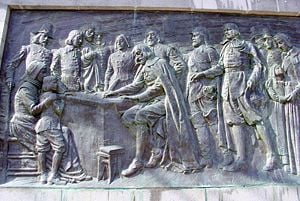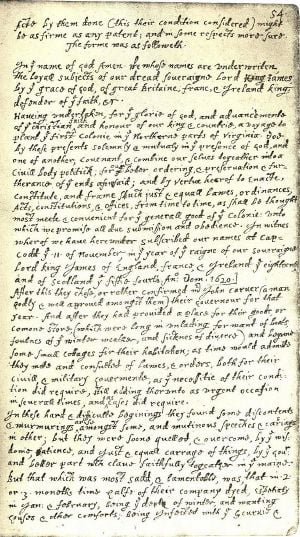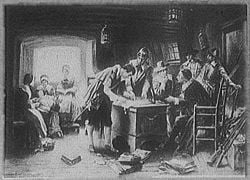Mayflower Compact

The Mayflower Compact was the first governing document of Plymouth Colony. It was drafted by the Pilgrims who crossed the Atlantic aboard the Mayflower, seeking religious freedom. Many of the passengers knew that earlier settlements in the New World had failed due to a lack of government, and the Mayflower Compact was in essence a social contract in which the settlers consented to follow the rules and regulations of the government for the sake of survival. The government, in return, would derive its power from the consent of the governed.
History of the Mayflower Compact
It was signed on November 11, 1620 (O.S.) in what is now Provincetown Harbor near Cape Cod. The Pilgrims used the Julian Calendar which, at that time, was ten days behind the Gregorian Calendar, signing the covenant "ye .11. of November" (literal). Having landed at Plymouth (so named by Captain John Smith earlier), many of the Pilgrims aboard realized that they were in land uncharted by the London Company. For this reason the Mayflower Compact was written and adopted, based simultaneously upon a majoritarian model and the settlers' allegiance to the king.
The Mayflower carried 102 passengers. 41 of these passengers were Pilgrims seeking a new situation where they could practice their religion in the manner they chose. The Pilgrims called the rest of the passengers "Strangers". These 61 people included merchants, craftsmen, skilled workers and indentured servants, and several young orphans. William Brewster and the other Pilgrim leaders organized the voyage and gathered these “strangers” to increase the chances of success. The voyage lasted more than two months. When they finally sighted land the captain of the Mayflower knew right away that they were far north of their destination so headed southward. This proved too dangerous and they were forced them to turn back and drop anchor in a harbor at the tip of Cape Cod.
Unrest started immediately. William Bradford later wrote that several “strangers” made “discontented and mutinous speeches.” Bradford went on to explain that the “Strangers” did not want to follow rules because “none had power to command them”. The Pilgrim leaders, with staunch determination to establish a colony amidst the brewing rebellion, knew they needed a temporary government authority. In England, such authority came from the king but in America it could only come from the people themselves. While still aboard the Mayflower, the Pilgrims and "Strangers" made a written agreement or compact among themselves.
It is assumed that William Brewster, who had a university education, wrote the Mayflower Compact. The pattern of church self-government used by the Pilgrims to establish their Separatist churches in England and Holland served as a model for political self-government in the Mayflower Compact. Almost all the adult male colonists, including two of the indentured servants, signed the document.
By signing the Mayflower Compact, the colonists in no way intended to declare their independence from England. The opening line of the Compact refers to both Pilgrims and "Strangers" as "loyal subjects" of King James. The Mayflower Compact is very short. It simply united the signers into a "Civil Body Politic" for the purpose of passing "just and equal Laws . . . for the general good of the Colony." However, those few words conveyed the idea of self-government for the first time in the New World.
The compact is often referred to as the foundation of the Constitution of the United States,[1] in a figurative, not literal, way, although is often mistakenly thought to be the first Constitution in America. The Fundamental Orders of Connecticut actually hold this honor.
As a side note, the 'dread soveraigne' referred to in the document used the archaic definition of dread; meaning awe and reverence (for the King), but not fear.
Text of the Mayflower Compact
The original document was lost, but the transcriptions in Mourt's Relation and William Bradford's journal Of Plymouth Plantation are in agreement and accepted as accurate. Bradford's hand written manuscript is kept in a special vault at the State Library of Massachusetts.[2] Bradford's transcription is as follows (Contains original 1630s spelling):
In ye name of God, Amen. We whose names are underwriten, ye loyall subjects of our dread soveraigne Lord King James by ye grace of God, of Great Britaine, Franc, & Ireland king, defender of ye faith, e&
Haveing undertaken, for ye glorie of god, and advancemente of ye Christian faith and honour of our king & countrie, a voyage to plant ye first colonie in ye Northerne parts of Virginia, doe by these presents solemnly & mutualy in ye presence of God, and one of another, covenant & combine our selves togeather into a civill body politick, for our better ordering & preservation & furtherance of ye ends aforesaid; and by vertue hearof to enacte, constitute, and frame such just & equall lawes, ordinances, Acts, constitutions, & offices, from time to time, as shall be thought most meete & convenient for ye generall good of ye Colonie, unto which we promise all due submission and obedience. In witnes wherof we have hereunder subscribed our names at Cap-Codd ye ·11· of November, in ye year of ye raigne of our soveraigne Lord King James, of England, France, & Ireland ye eighteenth, and of Scotland ye fiftie fourth. Ano: Dom. 1620.[3]
Signatories
The list of 41 male passengers who signed was supplied by Bradford's nephew Nathaniel Morton in his 1669 New England's Memorial. There are no surviving first-hand accounts of this information.[4]
- John Carver
- William Bradford
- William Brewster
- John Alden
- John Howland
- Stephen Hopkins
- Edward Winslow
- Gilbert Winslow
- Myles Standish
- John Allerton
- Isaac Allerton
- John Billington
- Thomas Tinker
- Samuel Fuller
- Richard Clark
- Richard Warren
- Edward Leister
- Thomas Rogers
- Thomas Williams
- Peter Brown
- John Turner
- Edward Tilly
- John Craxton
- Thomas Rogers
- John Goodman
- Edward Fuller
- Richard Gardiner
- William White
- Edmund Margeson
- George Soule
- James Chilton
- Francis Cooke
- Edward Doty
- Moses Fletcher
- John Rigdale
- Christopher Martin
- William Mullins
- Thomas English
- Richard Bitteridge
- Francis Eaton
- John Tilly
ReferencesISBN links support NWE through referral fees
- ↑ Adams, John Quincy (1802). in Manis, Jim: John Quincy Adams' Orations (PDF), Pennsylvania State University. Retrieved 2006-09-17.
- ↑ State Library of Massachusetts Online catalog
- ↑ Bradford, William (1898). "Book 2, Anno 1620", in Hildebrandt, Ted: Bradford's History "Of Plimoth Plantation" (PDF), Boston: Wright & Potter. Retrieved 2006-06-01.
- ↑ Morton, Nathaniel (1669). "2", in Rhys, Ernest: New England’s Memorial.
External Links
Template:USstatements
be-x-old:Мэйфлаўарская дамова de:Mayflower-Vertrag es:Pacto de Mayflower fr:Mayflower Compact nl:Mayflower Compact no:Mayflower Compact pl:Mayflower compact zh:五月花号公约
Credits
New World Encyclopedia writers and editors rewrote and completed the Wikipedia article in accordance with New World Encyclopedia standards. This article abides by terms of the Creative Commons CC-by-sa 3.0 License (CC-by-sa), which may be used and disseminated with proper attribution. Credit is due under the terms of this license that can reference both the New World Encyclopedia contributors and the selfless volunteer contributors of the Wikimedia Foundation. To cite this article click here for a list of acceptable citing formats.The history of earlier contributions by wikipedians is accessible to researchers here:
The history of this article since it was imported to New World Encyclopedia:
Note: Some restrictions may apply to use of individual images which are separately licensed.

